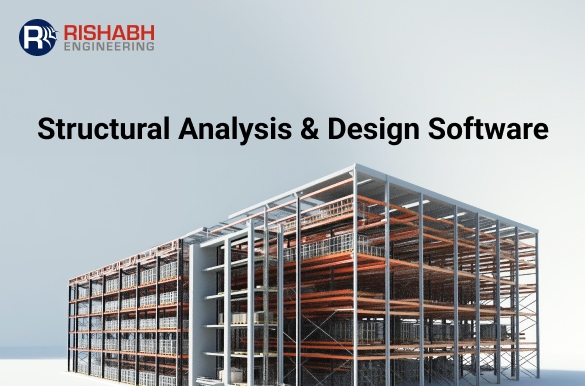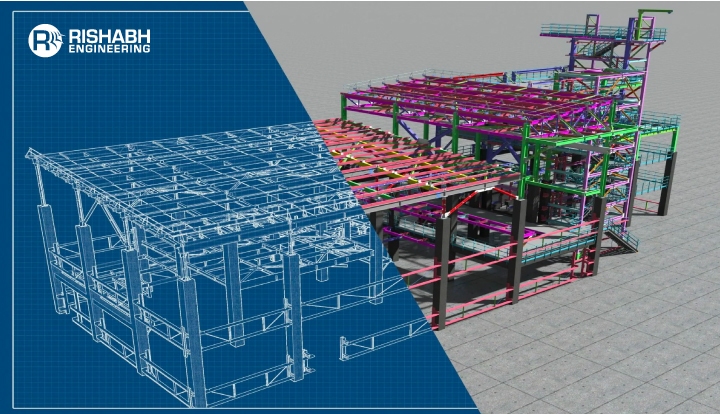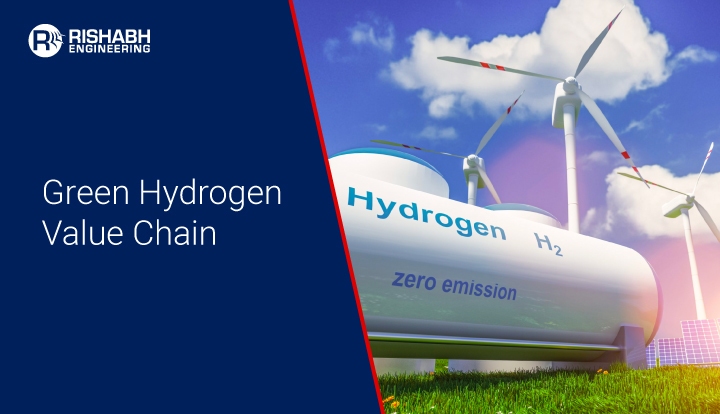
Coal Gasification Plant Design With Multidiscipline Engineering
Coal is still one of the most prevalent and strategically important fossil fuels in an era where the energy landscape is quickly changing toward sustainability. However, burning traditional coal presents significant environmental problems. Coal gasification has become a game-changing technology that connects traditional fossil fuel use with low-emission energy solutions as industry looks for greener alternatives. Our multidisciplinary experience in process, mechanical, piping, and instrumentation engineering puts Rishabh Engineering at the forefront of facilitating projects around the world.
In this blog, we’ll discuss the specifics of coal gasification plant design, including components, considerations, benefits along with potential challenges and how Rishabh Engineering can help solve them with multidiscipline design engineering.

What is Coal Gasification and How Does it Work?
Coal gasification is a process that turns coal into a gas instead of burning it. By heating at very high temperatures (over 1,000°C) and adding a small amount of oxygen or steam, it breaks down into a cleaner gas called syngas. This gas mainly contains H2 and CO, along with small amounts of other gases. Unlike traditional burning, where it is simply set on fire to produce heat, this process changes the coal’s chemical structure. And the result is a versatile gas that can be used to generate electricity, make chemicals, or even produce hydrogen for clean energy.
Coal Gasification Process
1. Coal Preparation:
- Raw coal is crushed and dried to an appropriate size and moisture level. It may be processed into slurry, powder, or pellets depending on the gasifier type.
2. Gasification Reaction:
- The prepared coal is fed into a gasifier, a high-pressure, high-temperature vessel.
- Inside, coal reacts with a controlled amount of oxygen and steam (not enough for full combustion).
- At temperatures between 1,200°C and 1,600°C, the coal breaks down through partial oxidation and chemical reactions, producing syngas.
3. Syngas Cleaning:
- The raw syngas contains impurities such as ash, sulfur compounds, particulates, and heavy metals.
- It passes through a series of cleaning units, including cyclones, filters, scrubbers, and acid gas removal systems to make it suitable for downstream use.
4. Syngas Utilization:
- The cleaned syngas can be:
- Burned in gas turbines for electricity (IGCC plants).
- Converted to ammonia, methanol, or synthetic fuels (via Fischer-Tropsch synthesis).
- Used in hydrogen production for refining and fuel cells.
Types of Coal Gasification Technologies
This gasification technologies are categorized based on how coal is fed into the gasifier, the flow of gas and solids, and the temperature and pressure conditions.
The primary types of coal gasification are listed below:
1. Fixed-Bed (Moving-Bed) Gasifiers
Example: Lurgi Gasifier
In this process, coal moves downward through a vertical reactor while gasifying agents (air, oxygen, steam) move upward.
Advantages: High thermal efficiency, good for lignite and bituminous coal.
Limitations: Slow reaction rates, higher tar and methane production, and limited coal type adaptability.
2. Fluidized-Bed Gasifiers
Examples: Winkler Gasifier (bubbling), KRW (circulating)
Coal particles are suspended in a bed of ash or inert material by upward-flowing gasifying agents.
Advantages: Uniform temperature distribution, good for low-grade coal and biomass blends.
Limitations: Lower carbon conversion efficiency compared to entrained-flow systems.
3. Entrained-Flow Gasifiers
Examples: GE (Texaco), Shell, Siemens
Pulverized coal and gasifying agents are injected at high pressure and temperature (up to 1,600°C).
Advantages: High carbon conversion, cleaner syngas with fewer tars and particulates, scalable.
Limitations: Requires finely ground coal, higher oxygen demand, and more complex equipment.
4. Underground Coal Gasification (UCG)
Gasification occurs in-situ, within an unmined coal seam underground. Oxidants are injected, and syngas is extracted to the surface.
Advantages: No need for coal mining, lower surface footprint.
Limitations: Difficult control reactions, environmental risks like groundwater contamination.
Each technology is selected based on factors like coal type, desired syngas quality, scale, and end-use application. Entrained-flow gasifiers are widely used in modern IGCC (Integrated Gasification Combined Cycle) and chemical plants due to their efficiency and syngas purity.
Benefits of Coal Gasification
This process offers a unique combination of environmental sustainability, energy flexibility, and economic viability. It enables the transformation of low-grade coal into cleaner, high-value products like syngas, hydrogen, ammonia, and synthetic fuels. This not only supports a more efficient use of domestic resources but also helps industries and governments meet their energy and emission targets through a diversified and scalable approach.
1. Energy Versatility
- Syngas can be used as fuel in Integrated Gasification Combined Cycle (IGCC) power plants.
- Improves thermal efficiency and reduces emissions compared to conventional combustion.
- Acts as a critical feedstock for:
- Hydrogen production
- Ammonia synthesis
- Methanol production
- Synthetic fuels via Fischer-Tropsch processes
2. Environmental Benefits: Produces lower emissions of:
- Sulfur dioxide (SO2)
- Nitrogen oxides (NOx)
- Particulate matter
3. Generates concentrated CO₂ streams, enabling cost-effective Carbon Capture and Storage (CCS).
4. Supports global decarbonization goals through cleaner fuel alternatives.
5. Economic Viability
- Utilizes low-grade or waste coal that’s otherwise unusable.
- Reduces reliance on imported fuels, enhancing energy security.
- Aligns with waste-to-energy strategies, especially in coal-rich regions.
- Suitable for industries with energy deficits or fluctuating fuel markets.
6. Scalability and Integration
- Modular and scalable design supports phased deployment.
- Enables flexible investment planning and expansion.
- Integrates well with renewable energy (solar/wind) and biomass co-gasification.
- Ideal for building hybrid clean energy systems.
Challenges In Coal Gasification and Their Solutions
This methodology is a promising and flexible energy conversion technology, but it comes with engineering and operational challenges that require careful planning and mitigation. These challenges range from feedstock inconsistencies and material degradation to process integration risks. Addressing them early in the design phase is critical to ensure safe, efficient, and economically viable plant performance.
Key Challenges and Mitigation Strategies:
Feed Variability & Ash Content
- Different coal types have varying moisture, ash, and volatile matter content.
- These variations affect gasifier performance, reaction stability, and syngas quality.
- Mitigation: Implement coal pretreatment (drying, grinding), feed blending systems, and flexible feed handling mechanisms.
Tars, Particulates & Trace Contaminants
- By-products like tars, mercury, arsenic, and ammonia can foul or corrode downstream equipment.
- These substances reduce syngas purity and may violate environmental standards.
- Mitigation: Integrate advanced syngas cleaning systems such as
- Wet scrubbers
- Cyclone separators
- Fabric filters
- Activated carbon beds for mercury removal
High-Temperature Material & Reactor Design
- Gasification temperatures often exceed 1200°C, subjecting materials to thermal shock, corrosion, and erosion.
- Poor material selection can lead to frequent downtime and increased maintenance.
- Mitigation: Use high-grade alloys, ceramic linings, and sophisticated cooling systems; conduct thermal stress analysis during design.
Scale-Up & Plant Integration Risks
- Lab- or pilot-scale gasifiers may not scale linearly to commercial capacities.
- Integration with utilities and downstream processes poses control and safety challenges.
- Mitigation: Employ:
- Computational simulation tools (CFD, process modeling)
- Dynamic process modeling
- HAZOP & risk assessments
- Modular or phased implementation strategies
Rishabh Engineering supports clients by providing multidisciplinary expertise across process, mechanical, structural, instrumentation, and safety domains. Their tailored engineering solutions help preempt operational risks and ensure optimized performance, regulatory compliance, and project scalability.
Components of a Coal Gasification Plant
A sophisticated facility helps turn coal into synthesis gas, or syngas, which is a mixture of methane (CH4), hydrogen (H2), carbon dioxide (CO2), and carbon monoxide (CO). As part of this process, the listed components below support gasification of coal in a regulated setting that enables maximizing conversion efficiency, reduce emissions, and generate useful chemical feedstocks or fuels. Let’s discuss them;
Coal Handling and Preparation System
This section involves receiving, crushing, and drying the coal to the desired size and moisture content. Pulverized or slurry coal is prepared for feeding into the gasifier.
Gasifier
The heart of the plant, where coal reacts with oxygen and steam at high temperatures (1,200–1,500°C) in a controlled, oxygen-deficient environment. Common types include fixed-bed, fluidized-bed, and entrained-flow gasifiers.
Oxidant Supply Unit
Supplies oxygen or air (sometimes enriched) to the gasifier. Oxygen is often preferred for producing cleaner syngas with higher energy content.
Syngas Cooling and Cleaning System
The raw syngas exiting gasifier contains particulates, tars, and contaminants like sulfur and mercury. These are removed using cyclones, scrubbers, filters, and catalytic converters.
Acid Gas Removal Unit
Removes hydrogen sulfide (H2S) and carbon dioxide using solvents like amine-based systems (e.g., Selexol, Rectisol) to prepare syngas for downstream use.
Syngas Conditioning and Utilization
The cleaned syngas may be adjusted (e.g., via water-gas shift reaction) to optimize the H2:CO ratio for applications such as ammonia, methanol, Fischer-Tropsch fuels, or power generation.
Ash and Slag Handling
Inorganic residues are removed as slag or ash and handled safely for disposal or reuse in construction materials.
Design Considerations of Coal Gasification Plant
Designing a fossil fuel gasification system involves multiple technical, economic, and environmental factors to ensure efficient syngas production, system reliability, and compliance with regulations.
Key considerations include:
1. Type and Quality of Coal
- The gasifier must be compatible with the rank, ash content, moisture, and reactivity of the coal.
- High-ash or low-grade coals require different handling and may influence gasifier type selection (e.g., fluidized-bed for high ash, entrained-flow for low ash).
2. Selection of Gasification Technology
The choice between fixed-bed, fluidized-bed, entrained-flow, or underground gasification depends on:
- Desired syngas composition
- Capital and operating costs
- Scale and feedstock flexibility
3. Operating Conditions
Optimal temperature (1,200°C–1,600°C) and pressure (20–80 bar) settings must be defined to ensure high conversion efficiency and minimal byproducts. And hence steam-to-carbon and oxygen-to-fuel ratios are carefully balanced for syngas quality.
4. Oxygen or Air Supply System
Systems using pure oxygen yield cleaner syngas but require expensive air separation units. And therefore air-blown systems are cheaper but dilute the syngas with nitrogen, reducing energy content.
5. Syngas Cleaning and Conditioning
Designing robust cleaning systems is essential to remove particulates, sulfur, mercury, and tars. It prepares the gas for downstream use in turbines or chemical synthesis.
6. Heat Recovery and Integration
Incorporate heat exchangers and waste heat boilers to recover energy from hot syngas and improve plant efficiency.
7. Environmental and Safety Compliance
Systems must control CO2, SO2, NOx, and particulate emissions. And finally it is vital to ensure safe handling of slag, ash, and toxic byproducts.
The Role of Multidiscipline Design Engineering
Coal gasification projects are inherently complex, requiring close coordination across multiple engineering disciplines. An integrated, multidisciplinary approach is vital to ensure process reliability, equipment safety, cost efficiency, and regulatory compliance. A cohesive team helps reduce design rework, resolve interface clashes, and streamline construction planning.
- Process Engineering plays a critical role in developing the process flow diagrams (PFDs), piping and instrumentation diagrams (P&IDs), heat and material balances, and reactor sizing. These are foundational to selecting the correct gasification route and configuring downstream treatment systems.
- Mechanical and Piping Engineering is essential for designing reactors, pressure vessels, piping layouts, and insulation strategies. This includes pipe stress analysis using tools like CAESAR II and 3D model integration for constructability.
- Civil and Structural Engineering ensures robust foundations and structural support, particularly for high-load units like gasifiers and scrubbers. Seismic and wind load design are also critical, especially for regions with challenging geographies.
- Electrical and Instrumentation Engineering manages power distribution, motor control centers (MCCs), instrument loops, control system architectures, and hazardous area classifications. This ensures automation, safety, and energy management across the plant.
- Safety and HAZOP Teams evaluate operational risks through scenario modeling (e.g., fire, explosion), SIL assessments, and compliance audits. Their input guides layout spacing, ESD systems, and safe venting strategies.
- Project Controls and Procurement synchronize engineering timelines, vendor coordination, and cost estimation. Their contribution is key to meeting project schedules and budget targets.
Rishabh Engineering brings these disciplines under one roof, ensuring comprehensive support throughout design, procurement, and execution stages of gasification projects.
How Rishabh Engineering Adds Value?
Rishabh Engineering offers end-to-end multidisciplinary engineering support to streamline the execution of gasification projects. From feasibility assessment to post-commissioning optimization, their integrated approach ensures reliability, efficiency, and alignment with project goals across all phases.
Front-End Engineering Design (FEED)
- Conducts techno-economic evaluations
- Performs site assessments and feasibility studies
- Aligns project design with client goals and investment strategies
Detailed Engineering & 3D Modeling
- Develops clash-free, construction-ready 3D designs using CADWorx and Navisworks
- Performs piping stress analysis with CAESAR II
- Conducts structural load analysis using STAAD.Pro
- Enhances accuracy and constructability while reducing rework
Simulation & Optimization
- Uses Aspen Plus and Aspen HYSYS to model syngas composition and reactor performance
- Evaluates heat recovery and energy integration strategies
- Applies PHAST for safety simulations, including QRA and fire/explosion modeling
- Ensures design compliance with environmental and safety regulations
Procurement & Vendor Support
- Prepares detailed equipment specifications
- Assists in vendor qualification and bid evaluations
- Manages RFQs, technical bid analysis, and inspection plans
Construction & Commissioning Support
- Coordinates with EPC contractors and OEMs for smooth project execution
- Offers site supervision and contractor/vendor liaison
- Conducts loop-checks, instrumentation calibration, and system integration
Operations Support & Upgrades
- Provides performance audits and operational diagnostics
- Conducts debottlenecking studies and supports plant revamps
- Enables lifecycle support to sustain long-term efficiency and ROI
With experience across energy, chemicals, and infrastructure domains, Rishabh Engineering adds value at every stage—translating complex gasification requirements into efficient, safe, and scalable projects.
Conclusion & Next Steps
Coal gasification is a cornerstone technology in the transition to a cleaner and more sustainable energy future. It transforms fossil fuels into hydrogen and other valuable chemicals, driving down carbon emissions and improving energy security. By tapping into local resources, nations can reduce their dependence on imported fuels, lessen environmental impact, and build infrastructure compatible with renewable energy systems and carbon capture solutions. However, the successful implementation of coal gasification projects demands complex design and perfect execution, as the process involves complex chemical reactions, high temperatures, and stringent environmental standards. This is where a multidisciplinary approach to design engineering becomes crucial.
At Rishabh Engineering, we specialize in providing comprehensive multidisciplinary engineering services. Our team of experts from various fields, including process, mechanical, civil, electrical, instrumentation, and safety engineering, collaborates seamlessly to address every aspect of coal gasification. We leverage advanced tools, technologies, and industry best practices to ensure that all phases of the project, from design to commissioning, are meticulously executed. By aligning our expertise across disciplines, we deliver high-quality, efficient, and safe solutions, effectively managing risks and ensuring long-term sustainability. Rishabh Engineering’s experience in executing large-scale projects ensures that coal gasification systems are optimized for both performance and compliance with global standards.
Looking For Coal Gasification Plant Design?
Connect with Rishabh Engineering for comprehensive, multidisciplinary support at every phase.
Related Blogs
Related Blogs
Best Structural Engineering Software for Accurate Analysis
Finding tools that simplify and improve the accuracy of the…
Detailed Engineering Considerations for Project Success
Engineering projects today require meticulous planning and execution across various…


